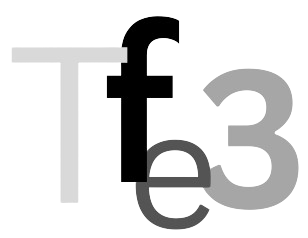Medical Literature
(Note: Outside Links – Some of these require a subscription or other fee to view the entire document.)
TFE3 Associated neurodevelopmental disorder:
- TFE3-associated neurodevelopmental disorder: A distinct recognizable syndrome (National Institutes of Health)
- De novo mutations in the X-linked TFE3 gene cause intellectual disability with pigmentary mosaicism and storage disorder-like features (National Institutes of Health)
- Lysosomal Signaling Licenses Embryonic Stem Cell Differentiation via Inactivation of Tfe3 (National Institutes of Health)
- TFE3-Associated Neurodevelopmental Disorder (TFE3) (Rare Genomics Institute)
- Transcription Factor for Immunoglobulin Heavy-Chain Enhancer 3; TFE3 (OMIM)
- Gene: TFE3 (Genomics England PanelApp)
Additional info and non-related TFE3 gene research:
- TFE3 Gene (GeneCards Human Gene Database)
- TFE3 (Wikipedia)
- P19532 TFE3_Human (UniProt)
- Nutrient-sensitive transcription factors TFEB and TFE3 couple autophagy and metabolism to the peripheral clock (National Institutes of Health)
- TFEB and TFE3, Linking Lysosomes to Cellular Adaptation to Stress (National Institutes of Health)
- Emerging roles of TFE3 in metabolic regulation (CDD Press)
- TFE3 transcription factor binding to IGHM enhancer 3 [Homo sapiens (human)] (National Library of Medicine)
- Human Gene TFE3 (uc004dmb.3) (UCSC Genomics Institute)
- Ragulator—a multifaceted regulator of lysosomal signaling and trafficking (Journal of Cell Biology)
- The lysosome as a command-and-control center for cellular metabolism (Journal of Cell Biology)
- The Rag GTPases-mTORC1-TFE3 Axis in Kidney Cancer and Neurodevelopment: A Mini Review (Journal of Neurology & Neuromedicine)
Genetic and Rare Disease Networks/Specialists
(We are currently aware of primarily USA based organizations, please let us know of any we should add, particularly what is available in other countries)
- GARD – Genetic and Rare Diseases Information Center (National Institutes of Health)
- NCATS – National Center for Advancing Translational Sciences (National Institutes of Health)
- Consultagene (Baylor College of Medicine)
- Rare Genomics Institute
- Mount Sinai Genetic Outreach (Mount Sinai Hospital)
- NORD – National Organization for Rare Disorders
- Undiagnosed Diseases Network (Harvard University)
- OTP – Office of Theraputic Products, Cellular & Gene Therapy Products (US FDA)
- How Gene Therapy Works (US FDA)
- Genomics England PanelApp (NHS)
- EveryLife Foundation for Rare Diseases
- n-lorem Foundation
Frequently Asked Questions
What is TFE3?
TFE3 stands for the Transcription Factor for immunoglobulin heavy-chain Enhancer 3 gene. This gene is involved in cell metabolism, maintaining the stability of cells, and helps regulate the specialization of stem cells into adult cells. TFE3 is located on the X-Chromosome; females are most commonly affected as they only have one X-Chromosome. The condition is a result of a “de novo mutation”, this means a new genetic change, not inherited from parents. It is unknown why this condition occurs.
How many TFE3 cases ARE there?
We aren’t automatically notified unless families contact us directly, so there may be more, but currently we know of about 40 cases worldwide, with a few more contacting us every year.
What are common symptoms?
Not every case displays all symptoms, but some of the most common are neurodevelopmental abnormality, facial dysmorphia (course facial features), pigmentary mosaicism (patterns of discoloration) on the skin, hypotonia, growth abnormality, and epilepsy.
How is this diagnosed?
The gold standard test for this condition is genetic testing – by taking a blood sample from the person affected and parents for comparison. Commonly these patients will also undergo other testing to rule out other similar conditions. This may include blood tests for other metabolic abnormalities. Lumbar puncture (to get spinal fluid) and brain imaging such as an MRI scan.
Is there any cure?
There is no cure yet, though research is ongoing. Currently, treatment is limited to medication for alleviation of seizures, sleep, and gastrointestinal symptoms, and physical, occupational and speech therapy to improve mobility, speech, etc.
Will my child ever walk or speak?
The known cases so far show a wide range of ability – some walk (at least a little), some don’t, some talk (to varying degrees), some don’t. Early diagnosis and persistent physical and speech therapy help considerably.
Therapy? What am I looking for?
Neurodevelopmental abnormality can interfere with the muscular control necessary for grasping, balance, crawling or walking, self-feeding, speech, etc. Because of these physical challenges, the self-motivation to do things that most children develop naturally is also commonly missing. Therapies that teach these motor skills specifically, build strength and body tone, and repetitively train motion into muscle-memory have shown to be effective.
Why a TFE3 registry?
The first step to helping our kids, is to build a secure registry where researchers and doctors can look at and analyze data and information about TFE3, as it presents itself in real people. Through the generosity of Castor, we are working to build such a registry. Key to gaining interest from researchers and beyond is seeing how many people are affected by the condition. That’s why we need you!
Please contact us for more information and to sign up for the registry!
About Community-Driven Registries
What else can I do?
This can feel overwhelming, it helps to reach out to others who know what you’re going through. We have TFE3 family groups on Facebook and Whats-App, both of these resources are highly recommended for any family facing a new TFE3 diagnosis. There are families there of TFE3 kids ranging in age from infant to early twenties. For more information about either, please contact us.
